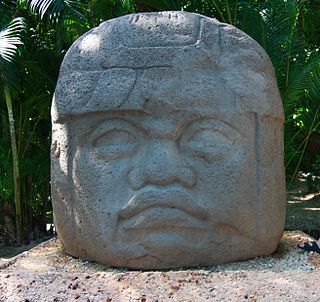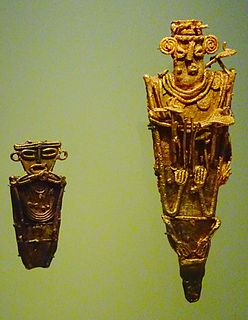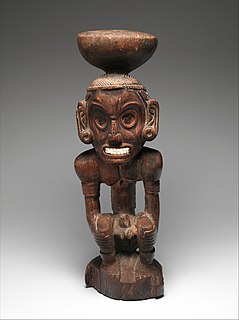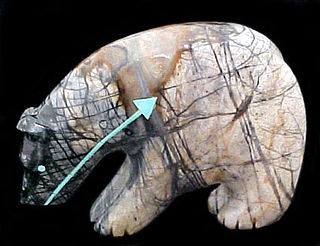 W
WBannerstones are artifacts usually found in the Eastern United States that are characterized by a centered hole in a symmetrically shaped carved or ground stone. The holes are typically 1⁄4" to 3⁄4" in diameter and extend through a raised portion centered in the stone. They usually are bored all the way through but some have been found with holes that extend only part of the way through. Many are made from banded slate or other colored hard stone. They often have a geometric "wing nut" or "butterfly" shape but are not limited to these. More than just functional artifacts, bannerstones are a form of art that appear in varying shapes, designs, and colors, symbolizing their ceremonial and spiritual importance.
 W
WChacmool is the term used to refer to a particular form of pre-Columbian Mesoamerican sculpture depicting a reclining figure with its head facing 90 degrees from the front, supporting itself on its elbows and supporting a bowl or a disk upon its stomach. These figures possibly symbolised slain warriors carrying offerings to the gods; the bowl upon the chest was used to hold sacrificial offerings, including pulque, tamales, tortillas, tobacco, turkeys, feathers and incense. In an Aztec example the receptacle is a cuauhxicalli. Chacmools were often associated with sacrificial stones or thrones.
 W
WHaida argillite carvings are a sculptural tradition among the Haida indigenous nation of the Northwest Coast of North America. It first became a widespread art form in the early 19th century, and continues today.
 W
WAn inuksuk or inukshuk is a manmade stone landmark or cairn built for use by the Inuit, Iñupiat, Kalaallit, Yupik, and other peoples of the Arctic region of North America. These structures are found in northern Canada, Greenland, and Alaska. This combined region, above the Arctic Circle, is dominated by the tundra biome and has areas with few natural landmarks.
 W
WMuiraquitã, is the name given to various types of old artefacts of Amazonian Indian origin, carved in stone or wood, and representing animals or people. Muiraquitãs are often used as pendants, amulets, and in other decorative capacities.
 W
WThe Olmec colossal heads are stone representations of human heads sculpted from large basalt boulders. They range in height from 1.17 to 3.4 metres. The heads date from at least 900 BC and are a distinctive feature of the Olmec civilization of ancient Mesoamerica. All portray mature individuals with fleshy cheeks, flat noses, and slightly crossed eyes; their physical characteristics correspond to a type that is still common among the inhabitants of Tabasco and Veracruz. The backs of the monuments often are flat. The boulders were brought from the Sierra de Los Tuxtlas mountains of Veracruz. Given that the extremely large slabs of stone used in their production were transported over large distances, requiring a great deal of human effort and resources, it is thought that the monuments represent portraits of powerful individual Olmec rulers. Each of the known examples has a distinctive headdress. The heads were variously arranged in lines or groups at major Olmec centres, but the method and logistics used to transport the stone to these sites remain unclear. They all display distinctive headgear and one theory is that these were worn as protective helmets, maybe worn for war or to take part in a ceremonial Mesoamerican ballgame.
 W
WPoporo is a device used by indigenous cultures in present and pre-Colombian South America for storage of small amounts of lime produced from burnt and crushed sea-shells. It consists of two pieces: the receptacle, and the lid which includes a pin that is used to carry the lime to the mouth while chewing coca leaves. Since the chewing of coca is sacred for the indigenous people, the poporos are also attributed with mystical powers and social status.
 W
WA tunjo is a small anthropomorh or zoomorph figure elaborated by the Muisca as part of their art. Tunjos were made of gold or tumbaga; a gold-silver-copper alloy. The Muisca used their tunjos in various instances in their religion and the small votive offering figures have been found in various places on the Altiplano Cundiboyacense, Colombia. Tunjos were used as offer pieces, to communicate with the gods and when the Muisca asked for favours from their deities. Muisca scholar Pedro Simón wrote about the tunjos of the Muisca.
 W
WThe Wrestler is a basalt statuette dating back to between 1500 BCE and 400 BCE, which some believe to be one of the most important sculptures of the Olmec culture. The near life-size figure has been praised not only for its realism and sense of energy, but also for its aesthetic qualities. Since 1964, the sculpture has been part of the collection of the Museo Nacional de Antropología in Mexico City.
 W
WA zemi or cemi was a deity or ancestral spirit, and a sculptural object housing the spirit, among the Taíno people of the Caribbean. They were also created by indigenous SouthAmericans.
 W
WZuni fetishes are small carvings made from primarily stone but also shell, fossils, and other materials by the Zuni people. Within the Zuni community, these carvings serve ceremonial purposes for their creators and depict animals and icons integral to their culture. As a form of contemporary Native American art, they are sold with secular intentions to collectors worldwide. Prior to the establishment of a non-Native market for fetishes, Hopi, Navajo, and other Pueblo peoples, especially at Kewa Pueblo also carved and used fetishes.